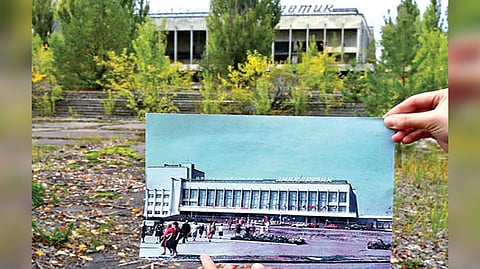

When people think about nuclear threats and the war in Ukraine, most consider two possibilities: What would happen if an accident occurred at a Ukrainian nuclear plant? And what would happen if a nuclear weapon were deployed? For this article, we talked to experts about the health impact the Fukushima and Chernobyl disasters had on surrounding populations, and asked them to explain the degree to which those disasters might provide a framework for our current understanding of risk at Zaporizhzhia.
Ukraine’s Zaporizhzhia power plant is located not far from the country’s southern border. This year it became the first active nuclear plant in history to continue operations in the midst of a war. Since occupying forces seized the plant in March, many across Europe have been wondering how a potential accident there would compare with the 1986 Chernobyl disaster — an event that for decades marked the worst nuclear power accident in history. The Chernobyl meltdown released radiation across Europe and tainted humans, plants and animals throughout the region.
Over 30 plant workers died in the three months following the disaster at the Soviet power station as a direct result of the meltdown. A report published by the Chernobyl Forum, a group of UN agencies formed in 2003 to assess the health and environmental consequences of the accident, suggested in 2006 that it will cause at least 4,000 cancer deaths in the long term, although that estimate is hotly debated. Some experts say the actual impact of the disaster was concealed by Soviet officials in an attempt to downplay its severity. One of them is Massachusetts Institute of Technology (MIT) professor Kate Brown.
She has conducted extensive research on the impact radiation has had on people’s health in Ukraine and surrounding countries since the 1986 accident. In a Greenpeace report published in 2006, researchers estimated the predicted death toll at around 90,000 — nearly 23 times the number suggested by the Chernobyl Forum report. Edwin Lyman, a physicist and director of Nuclear Power Safety with the US-based Union of Concerned Scientists, said he, “doesn’t consider the Chernobyl Forum report to be authoritative.”
Lyman said the Forum’s report based its cancer death predictions only on cases within the former Soviet Union, ignoring exposure to populations in other parts of Europe and the Northern Hemisphere. The original Chernobyl health impact report conducted by UN agencies and published in 1988, did address the global exposure to radiation in response to the accident, and estimated it would ultimately correspond to 30,000 or more cancer deaths, Lyman said.
“The fundamental issue is whether one believes that low-level exposures will cause cancer or not — and the worldwide expert consensus is that they do. The Chernobyl Forum essentially assumed otherwise,” he said, calling the study a “highly political document with conclusions that were carefully massaged to minimise the impacts of the accident.” Studies following the survivors of the Chernobyl disaster have shown an increase in cases of thyroid cancer. In the decades following the accident, researchers detected rates of that particular condition in young people in the former Soviet Union that were around three times higher than expected. This increase is partly attributed to the consumption of tainted milk, studies reported. However, according to Lyman, the large studies outlining overall cancer risk were published in the early 2000s, at a time when many cancers that could have been triggered by the Chernobyl disaster may not yet have started showing up. And nearly 20 years later, there hasn’t been any comprehensive follow-up to these reports.
Visit news.dtnext.in to explore our interactive epaper!
Download the DT Next app for more exciting features!
Click here for iOS
Click here for Android